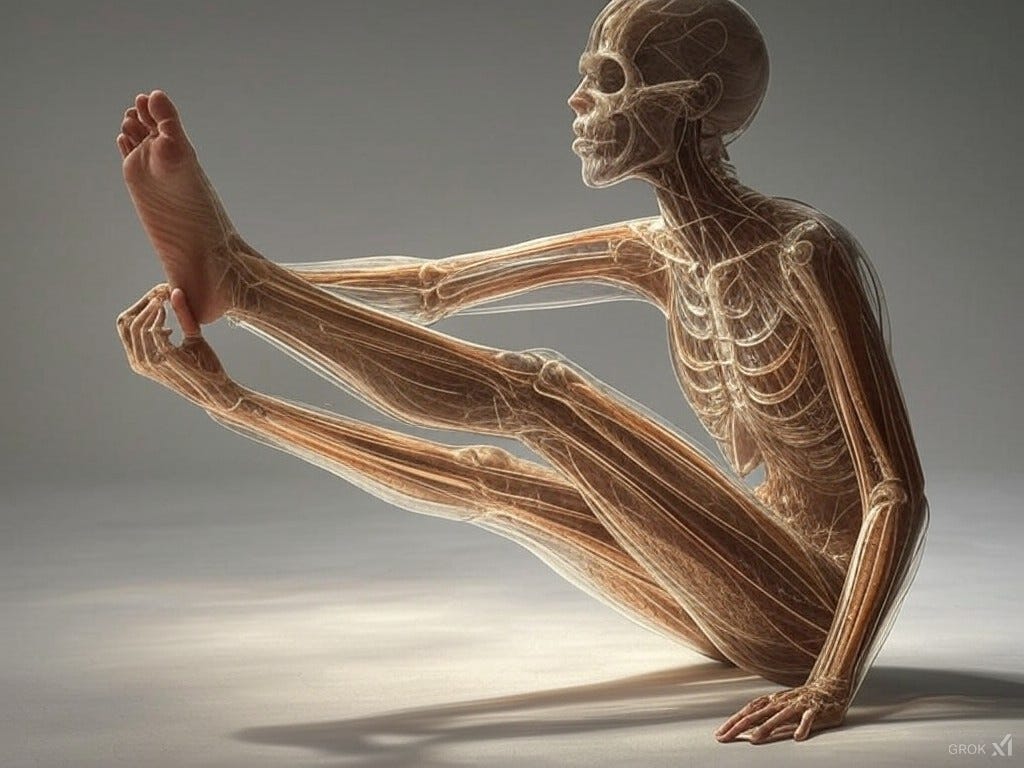Awareness Through Movement #369
Straightening the legs with holding the feet - with Megan Hopley
She’s back!!! Tonight Megan will walk us through this classic Feldy lesson :)

And because I’ll be doing this lesson, I don’t want to look at it so I simply pasted it in to Grok to ask what the anatomical benefits would be and it came back with:
Hip Joints: By lifting legs in various positions and directions, the movements engage the hip joints in a wide range of motion, which can help in realigning the femur within the hip socket. This realignment can lead to better hip stability and posture, as the hips are central to the body's balance.
Spine: The rolling movements and the coordination of lifting head with limbs encourage dynamic movement through the vertebrae, helping to maintain or restore the natural curvatures of the spine (cervical, thoracic, and lumbar). This can counteract the effects of prolonged sitting or poor posture habits.
Strengthening Muscles Around Joints: As muscles around joints like the hips, knees, and shoulders are strengthened through the movements, they provide better support to the bones. Stronger muscles help in pulling bones into proper alignment, which is crucial for good posture.
Ligament and Tendon Health: Regular, controlled movements can enhance the elasticity and strength of ligaments and tendons, which connect bones and muscles, ensuring that these connections allow for optimal bone positioning.
Back and Abdominal Muscles: Although the lesson avoids the term "core," the movements implicitly work on these muscles by involving actions that require stabilization from the back and abdominal regions. This activation helps in aligning the spine properly, reducing the likelihood of slouching or forward head posture.
Proprioception and Alignment:
Body Awareness: The movements enhance proprioception, the body's ability to sense its position in space. This heightened awareness can lead to subconscious adjustments in posture, aligning bones more naturally as one learns to feel when they are out of alignment.
Reducing Compression: Movements that involve extending arms and legs while rolling or lifting can gently decompress the spine, which is often compressed due to gravity or poor posture. This can lead to better vertical alignment of vertebral bodies.
Pelvic Tilts: The actions that involve spreading and moving legs while maintaining a connection between hands and feet can influence pelvic positioning. Proper pelvic alignment is crucial for the whole skeletal structure above it, influencing the natural curvature of the lower back and thus overall posture.
Weight-Bearing: Some movements mimic weight-bearing activities, which are known to contribute to bone health by stimulating bone density. Although this is more long-term, the dynamic nature of the movements can contribute to maintaining or improving bone density.
By engaging muscles in a way that supports and aligns bones, these movements can gradually correct or prevent misalignments that lead to poor posture. However, consistent practice and possibly integrating this with other forms of movement or therapy might be necessary for significant, lasting changes in skeletal alignment.
Keep reading with a 7-day free trial
Subscribe to MySelf.Study to keep reading this post and get 7 days of free access to the full post archives.

